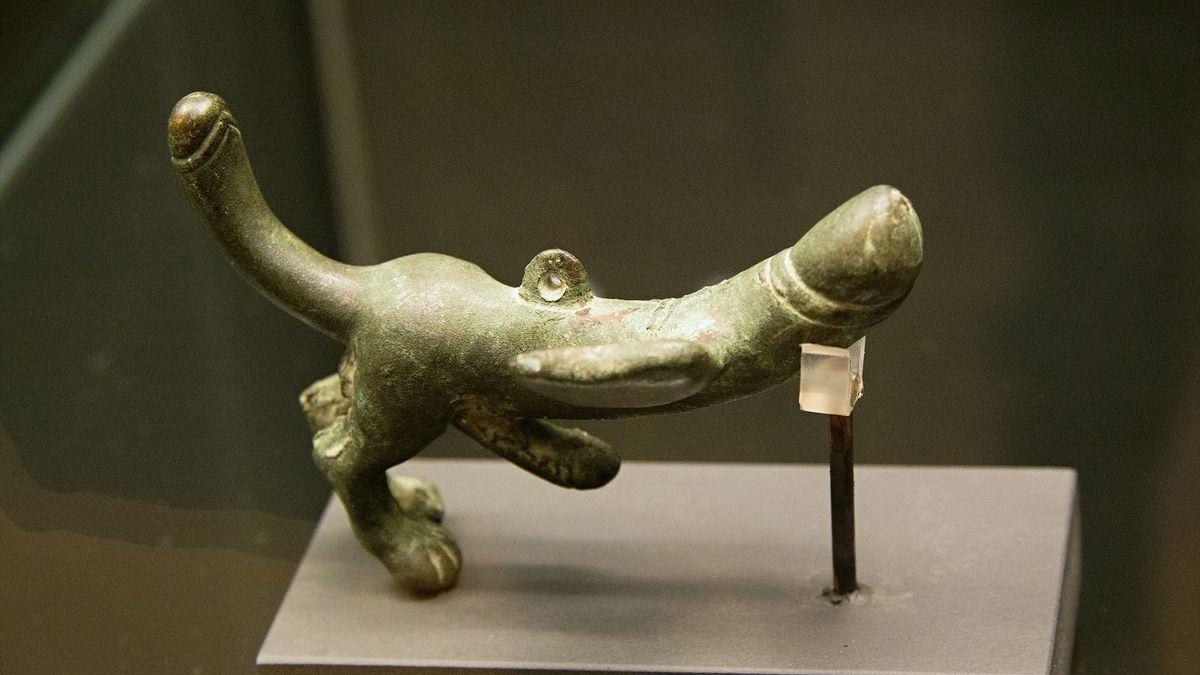Zdá se mi to nebo je to péro ? 😂
Phallic chimes from the Roman period
Categories: Nálezy nejenom s detektorem v západní Evropě
A winged Roman phallic chime with precise details and in complete condition was discovered last week on the site of the former Roman city of Viminacium in Serbia. It is only the second Roman tintinnabulum in Viminacium, and the only one found in its original archaeological context.
Viminacium was the capital of the Roman province of Moesia Superior. It had a large permanent military camp on the border with the Goths, and boasted the largest amphitheatre in the Balkans. The city's cemetery is the largest in the Roman Empire. Since its first discovery at the end of the 19th century, the city has been regularly archaeologically explored and is one of the most important sites of the Roman Empire. Finds at Viminacium make headlines several times a year. Current research is focused on the civilian settlement that grew up around the military base.
"The exploration of the civilian settlement of Viminacium has just begun and already the first significant discoveries have been made. During the excavation of one of the city's main streets, the gate of one of the buildings was discovered. The building was destroyed by fire, in which the porch collapsed and fell to the ground. An object known in scientific circles as a tintinnabulum was discovered in a layer of ashes," said Ilija Dankovic from the Institute of Archaeology in nearby Belgrade.
The tintinnabulum was often hung by or directly on doors as an amulet to ward off evil. They were usually made of bronze and came in many different forms. They could represent deities, humans, wolves, lions, winged animals, monsters and all combinations of these. Often more than one phallus would emerge from the figure.
Phallic objects or depictions of them are found on a wide range of Roman artifacts, from amulets to frescoes to mosaics and lamps. They were a symbol of good luck and protection from evil spirits. For the Romans, these objects were not erotic or lascivious. This part of the human body was seen as an effective weapon against harm and was also a carrier of good luck. They are usually dated to the 1st to 3rd centuries.
Pliny the Elder described in his works that young children and soldiers wore such amulets as divine protection. Children in the Roman period were quite often ill and their mortality rate was quite high. The riskiest period was up to the age of five. It is clear why mothers resorted to magical methods to protect their children. "It was for this reason that the owner of a house in Viminacium hung a tintinabulum outside his door. He believed it had powerful magical powers that could help him," the archaeologists conclude in their report from Viminacio.
The newly discovered chime was retrieved in one block so that it could be carefully examined in laboratory conditions. It now awaits careful cleaning and conservation, after which it will be presented to the public in its full glory.
Roman Nemec
Sources: livescience.com, sveoarheologiji.com

in situ

in situ - detail

tintinnabulum phallus with wings from Prague

viminacium was the military and civilian capital of the Roman province of upper moesia from the first to the fifth century

tintinnabulum with hippophallus from the Museum of London

tintinnabulum from Pompeii
The article is included in categories:
- Archive of articles > Archaeology > Finds and rescue research abroad > Nálezy nejenom s detektorem v západní Evropě
Post
Normální kůň, jen má tři ocasy. 
By asi pošťačka koukala. 
Typickej Trojskej kůň, tak zvanej, Trojkokot. 
He he. Já bych chtěl někdy najít ty sexuální žetony 
Zajímavý a poučný článek 
Gorbacofff: na nález první SPINTRIE stále na LP čekáme. Mám ale dojem, že jsou známé pouze z vykopávek v Pompeích. Tak ta šance asi nebude u nás vysoká :)
Elmara: Aha, tak to je škoda, to bych se u nálezu docela nasmál  Díky za info.
Díky za info.
Kdysi jsme dělali takové soutěže a jednom z dílů.... www.lovecpokladu.cz/home/lovci-historie-sesta-cast-souteze-pro-vsechny-hledace-s-detektory-kovu-5366
Lovci historie šestá část soutěže pro všechny hledače s detektory kovů | LovecPokladu.cz
V šestém díle se podíváme na pomezí Středočeského a Ústeckého kraje, prostě na sever po Labi. Na této řece leží velká část našich dějin a tak bychom kraje kolem ní nechtěli v naší soutěži vynechat. Tak máme vítěze! Velká gratulace pro Endlera a Blanku. V článku jsou doplněné fotografie nálezu a mapky, kde se to dalo :).
Divím se,že se k tomu ještě nevyjádřil Maso 🤔😀
Elmara: Díky za info 












